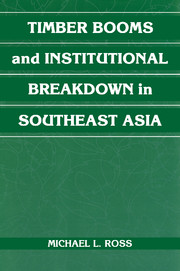Book contents
- Frontmatter
- Contents
- Illustrations
- Tables
- Preface
- 1 Introduction: Three Puzzles
- 2 The Problem of Resource Booms
- 3 Explaining Institutional Breakdown
- 4 The Philippines: The Legal Slaughter of the Forests
- 5 Sabah, Malaysia: A New State of Affairs
- 6 Sarawak, Malaysia: An Almost Uncontrollable Instinct
- 7 Indonesia: Putting the Forests to “Better Use”
- 8 Conclusion: Rent Seeking and Rent Seizing
- Appendix: Chronologies of Events
- References
- Index
5 - Sabah, Malaysia: A New State of Affairs
Published online by Cambridge University Press: 30 July 2009
- Frontmatter
- Contents
- Illustrations
- Tables
- Preface
- 1 Introduction: Three Puzzles
- 2 The Problem of Resource Booms
- 3 Explaining Institutional Breakdown
- 4 The Philippines: The Legal Slaughter of the Forests
- 5 Sabah, Malaysia: A New State of Affairs
- 6 Sarawak, Malaysia: An Almost Uncontrollable Instinct
- 7 Indonesia: Putting the Forests to “Better Use”
- 8 Conclusion: Rent Seeking and Rent Seizing
- Appendix: Chronologies of Events
- References
- Index
Summary
Qui Hing tells me he has contracted with Andy Goroo's people, the orang semoonals, to buy 500 planks for export. The dawn of a new state of affairs.
Diary of Sandakan founder William Pryer, August 1879 (John 1974: 56)In 1963, the British colonies of North Borneo, Sarawak, and Singapore joined the Federation of Malaya to create a new state, the Federation of Malaysia. Yet the former colony of North Borneo – now called Sabah – retained many of the powers of a sovereign state, including special control over immigration, religion, language, and land use. It also kept control of its forests, which remained exempt from the federal government's national forestry laws and taxes.
The Sabah government had good reasons to retain authority over its forests: they were densely packed with trees from the Dipterocarpaceae family – the same type that the Philippines so profusely exported. In 1953, Sabah held 2.7 percent of world hardwood market; by 1973, it had captured 20.1 percent of a much larger international market. Sabah was the world's second largest supplier of hardwood logs from 1959 to 1990 – second to the Philippines, then to Indonesia, and finally to its East Malaysian neighbor, Sarawak. Sabah's tiny city of Sandakan became one of the world's leading timber ports. Locals claimed it had more millionaires per capita than any city in the world.
Sabah's spectacular growth as a timber exporter, however, went hand-in-hand with the deterioration of its forestry institutions.
- Type
- Chapter
- Information
- Timber Booms and Institutional Breakdown in Southeast Asia , pp. 87 - 126Publisher: Cambridge University PressPrint publication year: 2001

